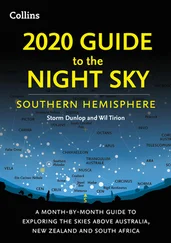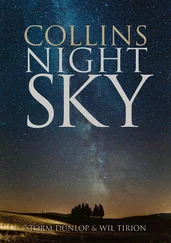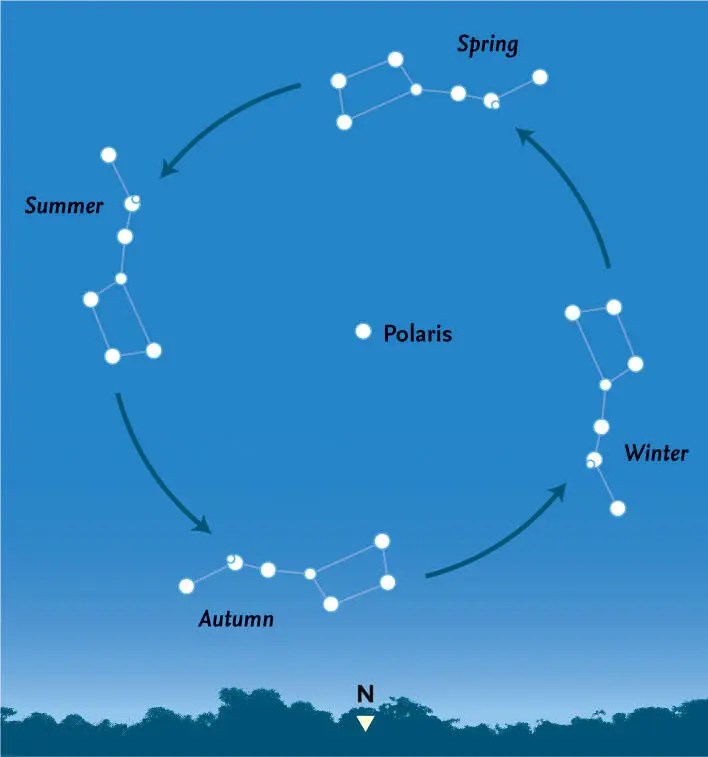
Cassiopeia
On the opposite of the North Pole from Ursa Major lies Cassiopeia. It is highly distinctive, appearing as five stars forming a letter ‘W’ or ‘M’ depending on its orientation. Provided the sky is reasonably clear of clouds, you will nearly always be able to see either Ursa Major or Cassiopeia, and thus be able to orientate yourself on the sky.
To find Cassiopeia, start with Alioth(ε Ursae Majoris), the first star in the tail of the Great Bear. A line from this star extended through Polaris points directly towards γ Cassiopeiae, the central star of the five.
Cepheus
Although the constellation of Cepheusis fully circumpolar, it is not nearly as well known as Ursa Major, Ursa Minor or Cassiopeia, partly because its stars are fainter. Its shape is rather like the gable end of a house. The line from the Pointers through Polaris, if extended, leads to Errai(γ Cephei) at the ‘top’ of the ‘gable’. The brightest star, Alderamin(α Cephei) lies in the Milky Way region, at the ‘bottom right-hand corner’ of the figure.
Draco
The constellation of Dracoconsists of a quadrilateral of stars, known as the ‘Head of Draco’ (and also the ‘Lozenge’), and a long chain of stars forming the neck and body of the dragon. To find the Head of Draco, locate the two stars Phecdaand Megrez(γ and δ Ursae Majoris) in the Plough, opposite the Pointers. Extend a line from Phecda through Megrez by about eight times their separation, right across the sky below the Guards in Ursa Minor, ending at Grumium(ξ Draconis) at one corner of the quadrilateral. The brightest star, Eltanin(γ Draconis) lies farther to the south. From the head of Draco, the constellation first runs northeast to Altais(δ Draconis) and ε Draconis, then doubles back southwards before winding its way through Thuban(α Draconis) before ending at Giausar(λ Draconis) between the Pointers and Polaris.
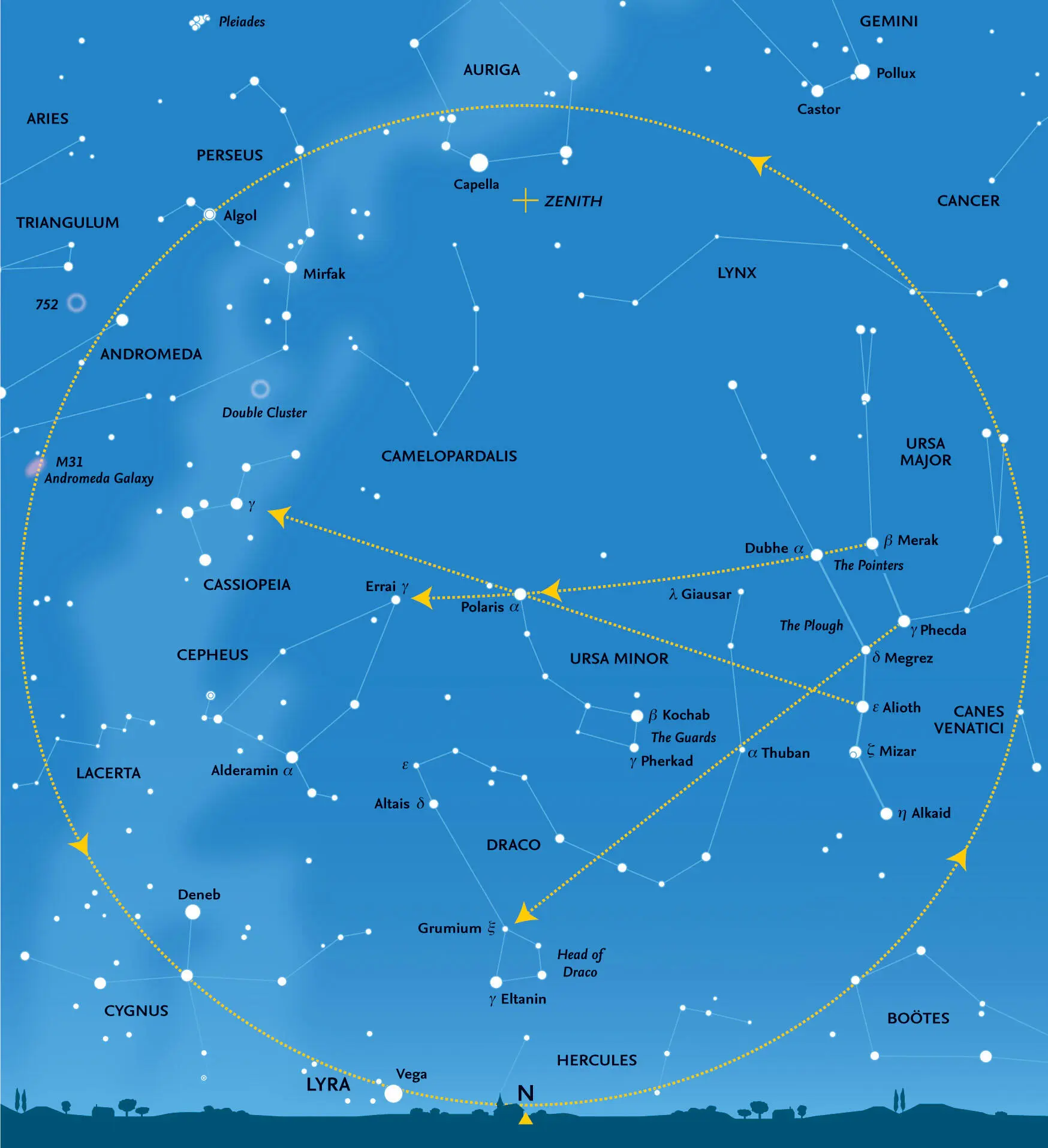
The stars and constellations inside the circle are always above the horizon, seen from our latitude.
The Winter Constellations
The winter sky is dominated by several bright stars and distinctive constellations. The most conspicuous constellation is Orion, the main body of which has an hourglass shape. It straddles the celestial equator and is thus visible from anywhere in the world. The three stars that form the ‘Belt’ of Orion point down towards the southeast and to Sirius(α Canis Majoris), the brightest star in the sky. Mintaka(δ Orionis), the star at the northeastern end of the Belt, farthest from Sirius, actually lies just slightly south of the celestial equator.
A line from Bellatrix(γ Orionis) at the ‘top right-hand corner’ of Orion, through Aldebaran(α Tauri), past the ‘V’ of the Hyades cluster, points to the distinctive cluster of bright blue stars known as the Pleiades, or the ‘Seven Sisters’. Aldebaran is one of the five bright stars that may sometimes be occulted (hidden) by the Moon. Another line from Bellatrix, through Betelgeuse(α Orionis), if carried right across the sky, points to the constellation of Leo, a prominent constellation in the spring sky.
Six bright stars in six different constellations: Capella(α Aurigae), Aldebaran(α Tauri), Rigel(β Orionis), Sirius(α Canis Majoris), Procyon(α Canis Minoris) and Pollux(β Gemini) form what is sometimes known as the ‘Winter Hexagon’. Pollux is accompanied to the northwest by the slightly fainter star of Castor(α Gemini), the second ‘Twin’.
In a counterpart to the famous ‘Summer Triangle’, an almost perfect equilateral triangle, the ‘Winter Triangle’, is formed by Betelgeuse (α Orionis), Sirius (α Canis Majoris) and Procyon (α Canis Minoris).
Several of the stars in this region of the sky show distinctive tints: Betelgeuse (α Orionis) is reddish, Aldebaran (α Tauri) is orange, and Rigel (β Orionis) is blue-white.
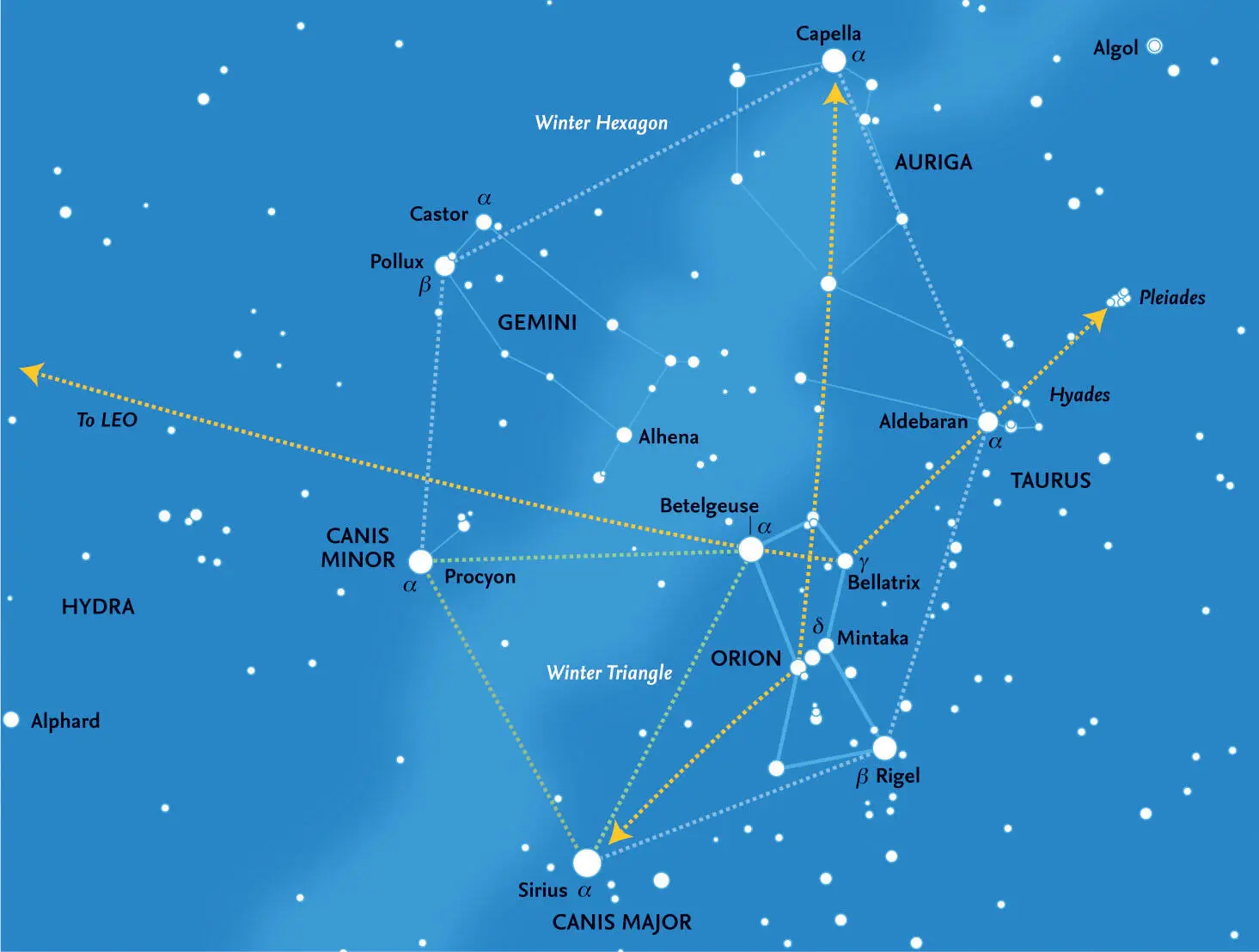
The Spring Constellations
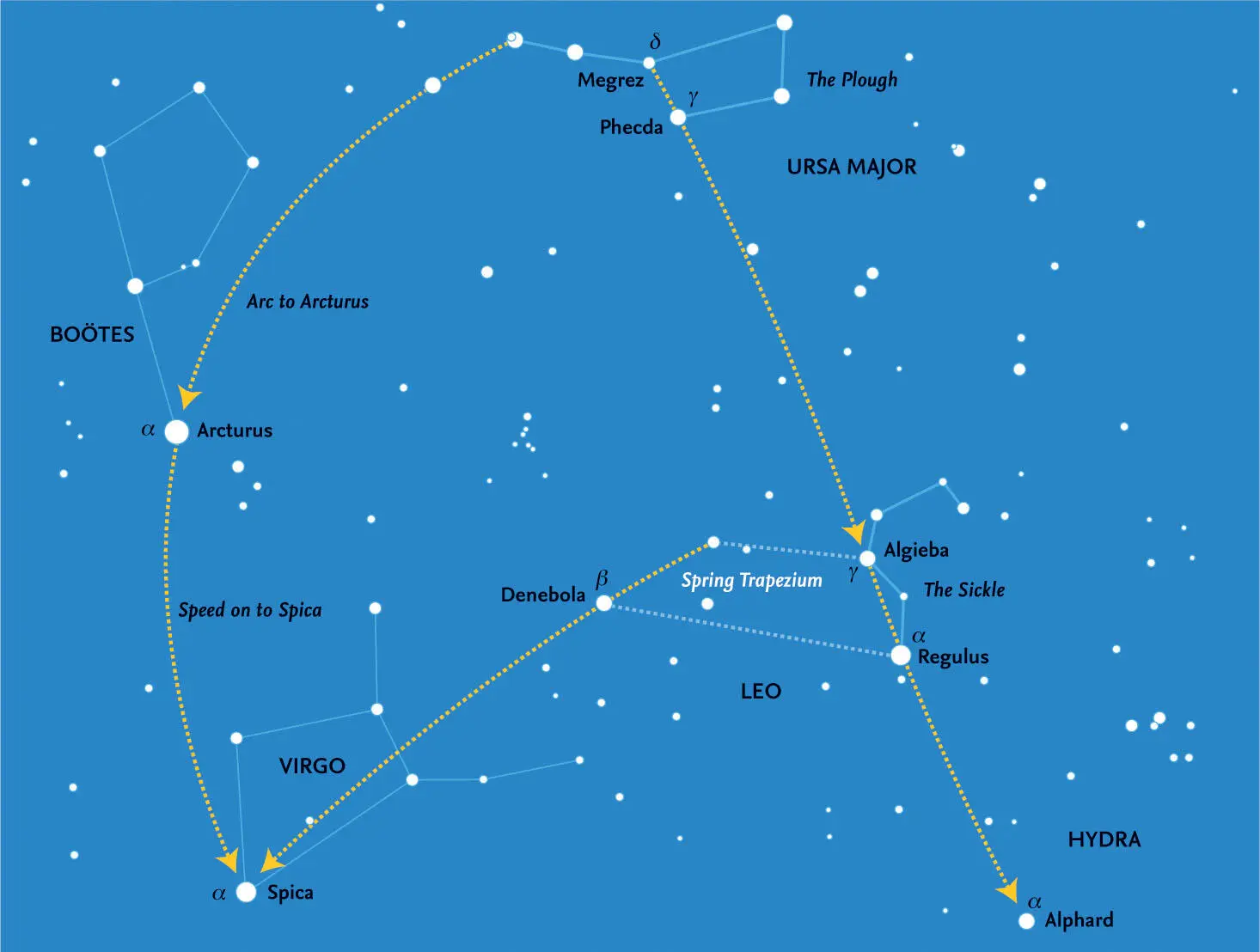
The most prominent constellation in the spring sky is the zodiacal constellation of Leo, and its brightest star, Regulus(α Leonis), which may be found by extending a line from Megrez and Phecda (δ and γ Ursae Majoris, respectively) – the two stars on the opposite side of the bowl of the Plough from the Pointers – down to the southeast. Regulus forms the ‘dot’ of the ‘backward question mark’ known as ‘the Sickle’. Regulus, like Aldebaran in Taurus, is one of the bright stars that lie close to the ecliptic, and that are occasionally occulted by the Moon. The same line from Ursa Major to Regulus, if continued, leads to Alphard(α Hydrae), the brightest star in Hydra, the largest of the 88 constellations.
The shape formed by the body of Leo is sometimes known as the ‘Spring Trapezium’. At the other end of the constellation from Regulus is Denebola(β Leonis), and the line forming the back of the constellation through Denebola points to the bright star Spica(α Virginis) in the constellation of Virgo. A saying that helps to locate Spica is well known to astronomers: ‘Arc to Arcturus and then speed on to Spica.’ This suggests following the arc of the tail of Ursa Major to Arcturus and then on to Spica. Arcturus(α Boötis) is actually the brightest star in the northern hemisphere of the sky. (Although other stars, such as Sirius, are brighter, they are all in the southern hemisphere.) Overall, the constellation of Boötesis sometimes described as ‘kite-shaped’ or ‘shaped like the letter P’.
Although Spica is the brightest star in the zodiacal constellation of Virgo, the rest of the constellation is not particularly distinct, consisting of a rough quadrilateral of moderately bright stars and some fainter lines of stars extending outwards.
The Summer Constellations
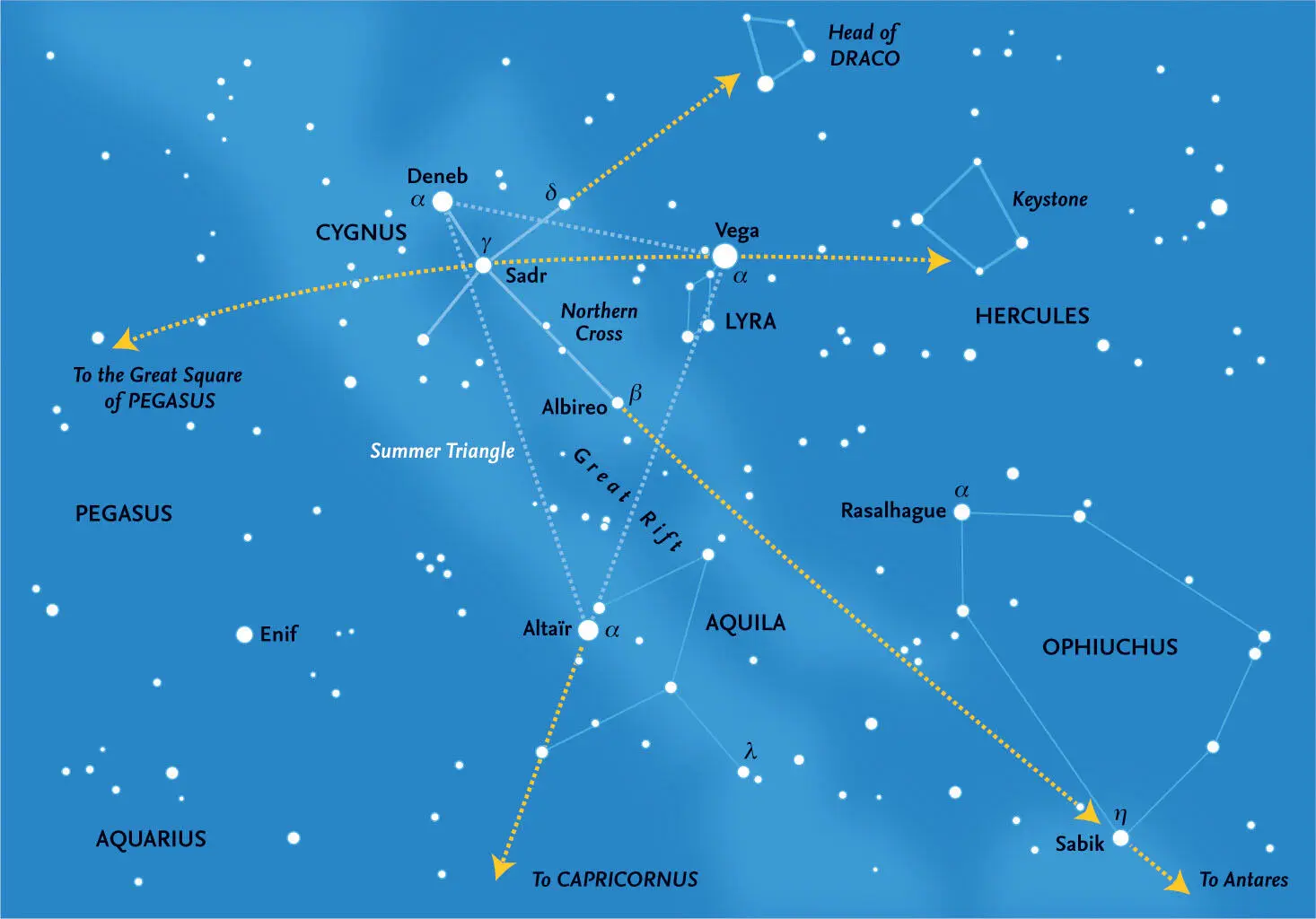
On summer nights, the three bright stars Deneb(α Cygni), Vega(α Lyrae) and Altair(α Aquilae) form the striking ‘Summer Triangle’. The constellations of Cygnus(the Swan) and Aquila(the Eagle) represent birds ‘flying’ down the length of the Milky Way. This part of the Milky Way contains the Great Rift, an elongated dark region, where the light from distant stars is obscured by intervening dust. The dark Rift is clearly visible even to the naked eye.
Читать дальше








